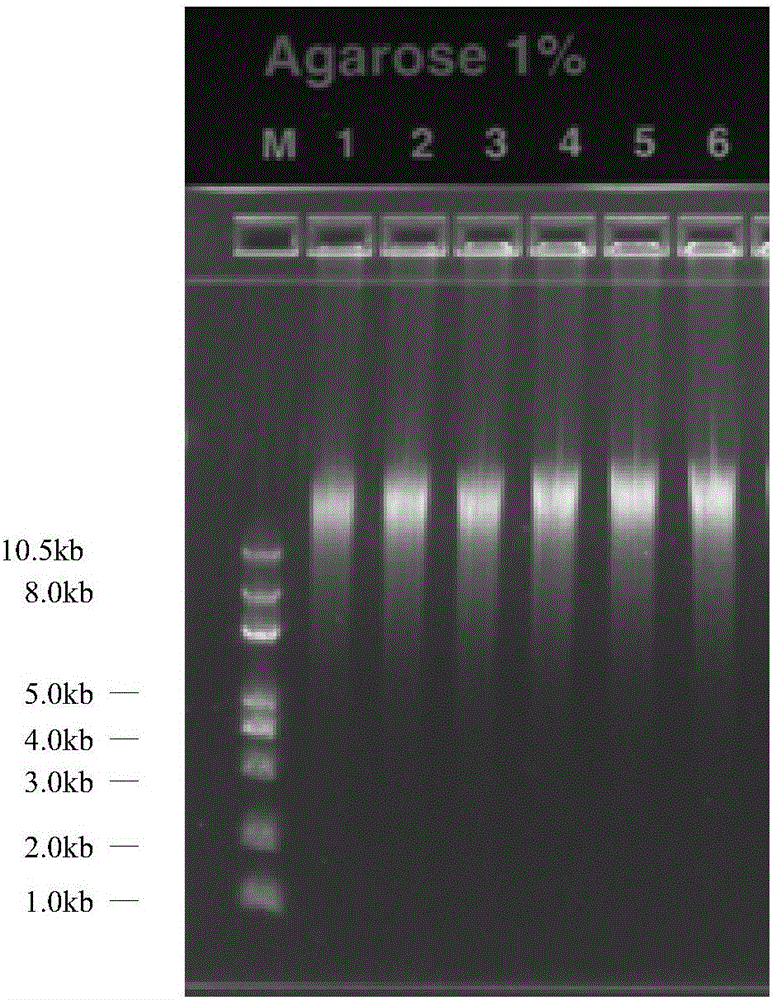Method for detecting trace fungus by using single-cell sequencing and kit
A single-cell sequencing and fungal technology, applied in the field of microorganisms and molecular biology, can solve the problems of difficult extraction of gDNA, fungal wall breaking, etc., and achieve the effect of good market prospects and considerable economic and social benefits.
- Summary
- Abstract
- Description
- Claims
- Application Information
AI Technical Summary
Problems solved by technology
Method used
Image
Examples
Embodiment 1
[0059] 1. Obtaining a small amount of Cryptococcus gattii cells: microscopic smear, laser cutting, and obtaining a single target cell
[0060] Apply a small amount of sample to a laser microdissection coated glass slide (Leica Membrane Slides PEN2.0 micron or similar product), use a laser microdissection system (Leica LMD7000 or similar product) to find the target cells under 63 times magnification, and use The laser intensity is 40 microjoules (the laser power range can be set to 40±3), and the selected single fungal cells are laser microdissected, and they are dropped into a sterile centrifuge tube. Repeat the above operation to obtain a total of 10 fungal cells (can be obtained Cell number range 1-100).
[0061] 2. Cell wall breaking of Cryptococcus gattii: Extraction of fungal protoplasts by combining chemical method and mixed enzyme method
[0062] 1) Add 200 μl of 0.8M D-sorbitol solution into the above centrifuge tube, soak the cells at 4°C for 2 hours;
[0063] 2) Pr...
Embodiment 2
[0081] 1. Obtaining a small amount of Candida Dublin cells: Microsmear, laser cutting, and obtaining a single target cell
[0082] Apply a small amount of sample to a laser microdissection coated glass slide (Leica Membrane Slides PEN2.0 micron or similar product), use a laser microdissection system (Leica LMD7000 or similar product) to find the target cells under 63 times magnification, and use The laser intensity is 43 microfocus (the laser power can be set to 40 ± 3) to perform laser microdissection on the selected single fungal cell, and it falls into a sterile centrifuge tube to obtain a total of 1 fungal cell (the range of cell number can be obtained 1-100 pieces).
[0083] 2. Cell wall breaking of Candida Dublin: Extraction of fungal protoplasts by combining chemical method and mixed enzyme method
[0084] 1) Add 200 μl of 0.8M D-sorbitol solution into the above centrifuge tube, soak the cells at 4°C for 2 hours;
[0085] 2) Prepare 100ml of composite pretreatment age...
Embodiment 3
[0102] 1. Acquisition of trace amounts of Malassezia cells: Microsmear, laser cutting, to obtain a single target cell
[0103] Apply a small amount of sample to a laser microdissection coated glass slide (Leica Membrane Slides PEN2.0 micron or similar product), use a laser microdissection system (Leica LMD7000 or similar product) to find the target cells under 63 times magnification, and use The laser intensity is 38 μJ (can be set to laser power 40±3) to perform laser microdissection on the selected single fungal cells, and drop them into sterile centrifuge tubes. Repeat the above operation to obtain a total of 60 fungal cells (can be obtained Cell number range 1-100).
[0104] 2. Malassezia cell wall breaking: the combination of chemical method and mixed enzyme method to extract fungal protoplasts
[0105] 1) Add 200 μl of 0.8M D-sorbitol solution into the above centrifuge tube, soak the cells at 4°C for 2 hours;
[0106] 2) Prepare 100ml of composite pretreatment agent: m...
PUM
 Login to View More
Login to View More Abstract
Description
Claims
Application Information
 Login to View More
Login to View More - R&D
- Intellectual Property
- Life Sciences
- Materials
- Tech Scout
- Unparalleled Data Quality
- Higher Quality Content
- 60% Fewer Hallucinations
Browse by: Latest US Patents, China's latest patents, Technical Efficacy Thesaurus, Application Domain, Technology Topic, Popular Technical Reports.
© 2025 PatSnap. All rights reserved.Legal|Privacy policy|Modern Slavery Act Transparency Statement|Sitemap|About US| Contact US: help@patsnap.com

